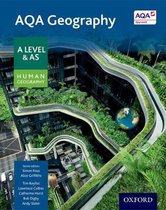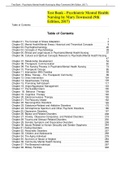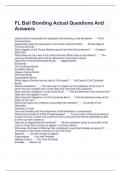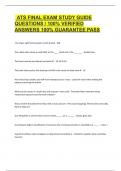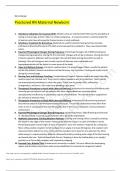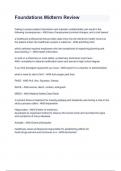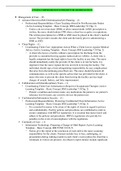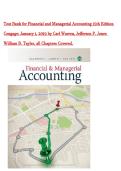WHAT IS A RESOURCE:
• Natural resources are any naturally occurring parts of the envo that can be used by people
to meet their needs
• They can be physical materials e.g. minerals: Iron ore or flows of energy e.g. sunlight + wind
Stock Resources:
• Can run out + cant be replaced in foreseeable future (within human timescales)
• Example = fossil fuels
Flow resources:
• Can be replenished
• Include resources that wont run out + don’t rely on human input to manage
• Examples = Sun, wind
• Include resources that may need careful management by humans to ensure they are
replenished e.g. wood -> critical flow resources
TYPES OF RESOURCES:
- Reserves = amount of the resource that’s economically viable to extract
- A resource = the entire supply of a material
Renewable resources:
• Any resource e.g. wood + solar that can be replenished naturally in the course of time
Non-renewable resource:
• A resource of economic value that cant be readily replaced by natural means on a level
equal to its consumption.
1. Possible resources
• Resources that are thought to exist but haven’t been sampled
2. Inferred resources
• Resources that have been identified but not measured
3. Indicated reserve
• The size of the reserve has been partly measured + measurements used to estimate actual
extent
4. Measured reserve
• Size of reserve = measured + known accurately
HOW DOES NATURAL RESOURCE USE DEVELOP OVER TIME:
1. Exploration
• Locating a potential new resource + evaluating whether it Is viable to extract it e.g. by
sampling + surveying the local area
2. Exploitation
• Extracting the resource, preparing it for use + transporting it to where it will be used
3. Depletion
• Resource begins to run out
4. Development
• As yields decrease, new methods of extraction may be developed to prolong life of resource
5. Resource exhausted
• Resource becomes so limited that it isn’t physically possible/economically viable to extract
,Resource Frontiers
WHAT:
1) A place with abundant natural resources that are being exploited for the 1st time
o These areas often haven’t been exploited before -> geographically remote (e.g. Arctic) /
hard to access (e.g. mountainous or sub-sea areas)
2) RF’s often develop as other, more accessible resources are depleted
o Ongoing/increasing demand makes it necessary or economically viable to exploit areas
that weren’t previously worth exploiting
1) As a RF begins to be exploited for its resources, new facilities + equipment are needed
o New buildings (e.g. for housing workers) + transport links may also be constructed
EXAMPLE: THE ARCTIC
1) Some areas contain rich resources of oil + natural gas + minerals (e.g. iron ore + gold)
2) Many haven’t been exploited for several reasons:
o Hard to access – 80%+ of Arctic’s gas + oil is offshore
o Little infrastructure – (roads/pipelines) makes extraction + transportation hard
o Challenging envo – sea ice makes transportation difficult + extreme cold + winter
storms put equipment + workers at risk
o Concerns about damaging the environment
3) Some resources are being exploited here e.g. large oil reserves were discovered at Prudhoe
Bay Alaska in 1968
o In 70s Trans-Alaska pipeline constructed to carry oil to southern Alaska
4) In some Fortier areas, exploitation stopped
o E.g. 2015 Shell stropped drilling in Chukchi Sea (Alaska) because of costs + reserves
were smaller than expected -> not economically viable
THE RESOURCE PEAK:
The period of highest production = resource peak
- When a new stock resource is found + exploited the amount extracted each day/week tends to
follow a similar pattern:
1) Initially production increases as investment increases (more
workers, more money spent on equipment etc) + the most
easily accessed parts of the reserve = exploited
2) The graph of resource production = bell-shaped curve
• Shows a normal distribution
• Resource peak = the point at which maximum amount of
the resource is being extracted each day (tends to be
when 50% of resource has been used)
3) Production declines - most accessible parts = exhausted
- The resource peak can be applied at a local scale (e.g. single mine or field) or at global scale
- In some cases, new tech can cause a second peak/ slowing down of depletion as it allows hard-
to-reach reserves to be exploited
o E.g. hydraulic fracturing has allowed exploitation of unconventional oil reserves in
shale
, ‘Assess the extent to which exploitation of resource frontier regions is likely to be necessary in
future.’ (9)
Define: a resource frontier is an areas on the periphery of a country or territory which is being
opened up for resource extraction as older, more accessible resource locations become exhausted
Necessary:
1. Population is growing – more people need resources
a. 6.5bn in 2005 -> 9.1 bn by 2050
b. More mobiles in the world than people – huge consumer of resources
2. Developing countries want to urbanise – this requires minerals + fuel
a. China -> 221 cities with 1m people by 2025
b. 50,000 towers blocks together with associated infrastructure
c. 13.8m cars sold in China in 2010 -> between 2000 and 2010 car ownership increased
20x -> in 2030 there will be more cars in China than there were in the entire world in
2000
d. All of these developments need fuel + material
3. The development of renewable energy will require huge amounts of minerals + energy
a. Wood has a low energy density
b. Enthanol crops grown using petroleum based agriculture -> lower energy renewal +
uses a huge amount of land (in US to supply all power via biofuels would require 2x
the amount of land used in the agricultural industry)
c. Hydropower only available on coastal areas
d. Hydrogen economy is not economical or viable – takes more energy to take
hydrogen out of the gas than is retrieved from the hydrogen
e. All the solar power in the world is only equivalent to 2 coal fired power stations in
terms of electricity production
4. Oil extraction peak has been reached in 64 of the 75 oil producing nations + it is now harder
to extract oil as more energy is used to do so
a. 1 barrel is used to extract 10 barrels (EROEI = 10)
b. Crude and shale extraction is difficult + the energy value of these supplies is bery
low – a pan of shale is the same a box of breakfast cereal
5. We depend so heavily of fossil fuels
a. Oil powers 96% of all US transportation
b. 50% of the worlds power is provided by coal burning – peak likely to be reached
2040
c. We would need 10,000 nuclear plants to replace all our fossil fuel based electricity
use
d. The average American uses as much energy as 150 slaves working 24 hours a day
Unnecessary:
1. Development of tech means we can be more efficient
a. Development of sustainable energy
i. Solar
ii. Wind
iii. Hydro
b. Chemical metal extraction – hydrometallurgy
i. Metal could be produced without putting carbon into the atmosphere if a
clean form of electricity is used
ii. Widens the base of resources we can utilise
2. Exploiting new resource frontiers will be extremely difficult as the areas easiest to exploit
will have been exhausted

